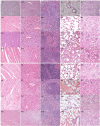Curing the Toxicity of Multi-Walled Carbon Nanotubes through Native Small-molecule Drugs
- PMID: 28588210
- PMCID: PMC5460272
- DOI: 10.1038/s41598-017-02770-5
Curing the Toxicity of Multi-Walled Carbon Nanotubes through Native Small-molecule Drugs
Abstract
With the development and application of nanotechnology, large amounts of nanoparticles will be potentially released to the environment and possibly cause many severe health problems. Although the toxicity of nanoparticles has been investigated, prevention and treatment of damages caused by nanoparticles have been rarely studied. Therefore, isotope tracing and improved CT imaging techniques were used to investigate the biodistribution influence between oMWCNTs(oxidized multi-walled carbon nanotubes) and 1,2-dioleoyl-sn-glycero-3-phosphocholine (DOPC)/or simvastatin (TD) in vivo. What's more, biochemical indices in plasma and tissue histology were measured to further study therapeutic effects on the damages of oMWCNTs in mice. Isotope tracing and improved CT imaging results showed that low dosages of DOPC and TD didn't affect the distribution of oMWCNTs in mice; conversely, the distribution and metabolism of DOPC and TD were influenced by oMWCNTs. Moreover, DOPC and/or TD improved the biocompatibility of oMWCNTs in erythrocyte suspension in vitro. Biochemical index and histopathological results indicated that DOPC and TD didn't prevent injuries caused by oMWCNTs effectively. But TD showed a good therapeutic effect for damages. This study is the first to investigate prevention and treatment effects of drugs on damages caused by oMWCNTs and provides new insights and breakthroughs for management of nanoparticles on health hazards.
Conflict of interest statement
The authors declare that they have no competing interests.
Figures









Similar articles
-
Biodistribution of co-exposure to multi-walled carbon nanotubes and nanodiamonds in mice.Nanoscale Res Lett. 2012 Aug 23;7(1):473. doi: 10.1186/1556-276X-7-473. Nanoscale Res Lett. 2012. PMID: 22913534 Free PMC article.
-
The effect of multiwalled carbon nanotubes on hepatotoxicity of Cd2+ in accumulated cadmium-metallothione in mice.Biomed Res Int. 2014;2014:463161. doi: 10.1155/2014/463161. Epub 2014 Sep 2. Biomed Res Int. 2014. PMID: 25276789 Free PMC article.
-
Long-term in vivo biocompatibility of single-walled carbon nanotubes.PLoS One. 2020 May 6;15(5):e0226791. doi: 10.1371/journal.pone.0226791. eCollection 2020. PLoS One. 2020. PMID: 32374764 Free PMC article.
-
The role of nanotoxicology in realizing the 'helping without harm' paradigm of nanomedicine: lessons from studies of pulmonary effects of single-walled carbon nanotubes.J Intern Med. 2010 Jan;267(1):106-18. doi: 10.1111/j.1365-2796.2009.02188.x. J Intern Med. 2010. PMID: 20059647 Review.
-
Mechanisms of pulmonary toxicity and medical applications of carbon nanotubes: Two faces of Janus?Pharmacol Ther. 2009 Feb;121(2):192-204. doi: 10.1016/j.pharmthera.2008.10.009. Epub 2008 Dec 6. Pharmacol Ther. 2009. PMID: 19103221 Review.
Cited by
-
Towards the Extraction of Radioactive Cesium-137 from Water via Graphene/CNT and Nanostructured Prussian Blue Hybrid Nanocomposites: A Review.Nanomaterials (Basel). 2019 May 2;9(5):682. doi: 10.3390/nano9050682. Nanomaterials (Basel). 2019. PMID: 31052518 Free PMC article. Review.
-
Toxicity of multi-wall carbon nanotubes inhalation on the brain of rats.Environ Sci Pollut Res Int. 2020 Apr;27(11):12096-12111. doi: 10.1007/s11356-020-07740-5. Epub 2020 Jan 27. Environ Sci Pollut Res Int. 2020. PMID: 31984464
-
Decadal Journey of CNT-Based Analytical Biosensing Platforms in the Detection of Human Viruses.Nanomaterials (Basel). 2022 Nov 23;12(23):4132. doi: 10.3390/nano12234132. Nanomaterials (Basel). 2022. PMID: 36500755 Free PMC article. Review.
-
Recent advances in graphene-based nanomaterials: properties, toxicity and applications in chemistry, biology and medicine.Mikrochim Acta. 2019 Jun 1;186(6):395. doi: 10.1007/s00604-019-3458-x. Mikrochim Acta. 2019. PMID: 31154528 Review.
-
Carbon Nanotubes as Carriers in Drug Delivery for Non-Small Cell Lung Cancer, Mechanistic Analysis of Their Carcinogenic Potential, Safety Profiling and Identification of Biomarkers.Int J Nanomedicine. 2022 Dec 8;17:6157-6180. doi: 10.2147/IJN.S384592. eCollection 2022. Int J Nanomedicine. 2022. PMID: 36523423 Free PMC article. Review.
References
-
- Heli H, Pishahang J. Cobalt oxide nanoparticles anchored to multiwalled carbon nanotubes: synthesis and application for enhanced electrocatalytic reaction and highly sensitive nonenzymatic detection of hydrogen peroxide. Electrochim Acta. 2014;123:518–526. doi: 10.1016/j.electacta.2014.01.032. - DOI
Publication types
MeSH terms
Substances
LinkOut - more resources
Full Text Sources
Other Literature Sources

